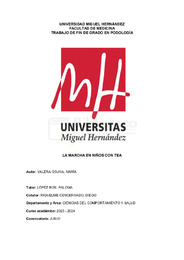Please use this identifier to cite or link to this item:
https://hdl.handle.net/11000/33407Full metadata record
| DC Field | Value | Language |
|---|---|---|
| dc.contributor.advisor | López Ros, Paloma | - |
| dc.contributor.author | Valera Osuna, María | - |
| dc.contributor.other | Departamentos de la UMH::Ciencias del Comportamiento y salud | es_ES |
| dc.date.accessioned | 2024-10-04T07:44:19Z | - |
| dc.date.available | 2024-10-04T07:44:19Z | - |
| dc.date.created | 2024-06-01 | - |
| dc.identifier.uri | https://hdl.handle.net/11000/33407 | - |
| dc.description.abstract | Introducción: El trastorno del espectro autista (TEA) es un trastorno del neurodesarrollo caracterizado por limitaciones a nivel conductual, comunicativo y social, afectando a 1 de cada 160 niños. La mayoría presenta algún tipo de afectación del desarrollo, motora, psíquica o médica. En las afectaciones motoras, encontramos alteraciones en la marcha con el propósito de tener una mayor estabilidad para compensar las alteraciones en el sistema vestibular y visual. La marcha en puntillas es una de las variaciones, determinado por la ausencia de apoyo de talón en la marcha. Método: Es un estudio descriptivo observacional retrospectivo del pie y la marcha en 25 personas con TEA con edades comprendidas entre 3 y 19 años. Resultados: El test de Craig y la movilidad de tobillo obtuvieron valores significativamente alterados. El eje muslo – pie y ángulo de la marcha determinan una prevalencia hacia marcha en abducción. PRCA, test de Jack y HRT fueron las pruebas con menos valores alterados. Conclusiones: Los sujetos presentan alteraciones estructurales y funcionales. La prevalencia de la marcha de puntillas es del 28%. Las rotaciones de cadera obtuvieron valores alterados. La torsión externa tibial fue de un 72%. | es_ES |
| dc.description.abstract | Introduction: Autism spectrum disorder (ASD) is a neurodevelopmental disorder characterized by behavioral, communicative and social limitations, affecting 1 in 160 children. The majority present some type of developmental, motor, psychological or medical impairment. In motor impairments, we find alterations in gait with the purpose of having greater stability to compensate for alterations in the vestibular and visual system. Walking on tiptoe is one of the variations, determined by the absence of heel support when walking. Method: It is a retrospective observational descriptive study of foot and gait in 25 people with ASD aged between 3 and 19 years. Results: The Craig test and ankle mobility obtained significantly altered values. The thigh-foot axis and gait angle determine a prevalence towards abduction gait. PRCA, Jack's test and HRT were the tests with the least altered values. Conclusions: The subjects present structural and functional alterations. The prevalence of tiptoe walking is 28%. Hip rotations obtained altered values. Tibial external rotation was 72%. | es_ES |
| dc.format | application/pdf | es_ES |
| dc.format.extent | 52 | es_ES |
| dc.language.iso | spa | es_ES |
| dc.publisher | Universidad Miguel Hernández | es_ES |
| dc.rights | info:eu-repo/semantics/openAccess | es_ES |
| dc.rights | Attribution-NonCommercial-NoDerivatives 4.0 Internacional | * |
| dc.rights.uri | http://creativecommons.org/licenses/by-nc-nd/4.0/ | * |
| dc.subject | trastorno del espectro autista | es_ES |
| dc.subject | niño | es_ES |
| dc.subject | marcha en puntillas | es_ES |
| dc.subject | rotación externa tibial | es_ES |
| dc.subject | pies | es_ES |
| dc.subject.other | CDU::6 - Ciencias aplicadas | es_ES |
| dc.title | La marcha en niños con TEA | es_ES |
| dc.type | info:eu-repo/semantics/bachelorThesis | es_ES |

View/Open:
TFG LA MARCHA EN NIÑOS CON TEA - MVO.pdf
7,18 MB
Adobe PDF
Share:
.png)
